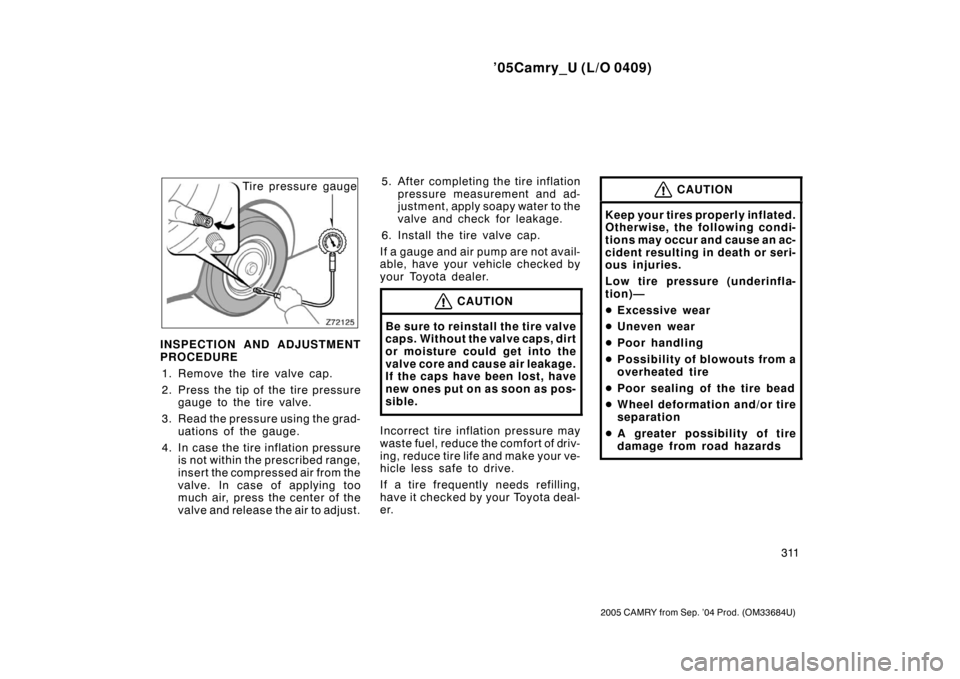Page 319 of 352

’05Camry_U (L/O 0409)
311
2005 CAMRY from Sep. ’04 Prod. (OM33684U)
Tire pressure gauge
INSPECTION AND ADJUSTMENT
PROCEDURE 1. Remove the tire valve cap.
2. Press the tip of the tire pressure gauge to the tire valve.
3. Read the pressure using the grad- uations of the gauge.
4. In case the tire inflation pressure
is not within the prescribed range,
insert the compressed air from the
valve. In case of applying too
much air, press the center of the
valve and release the air to adjust. 5. After completing the tire inflation
pressure measurement and ad-
justment, apply soapy water to the
valve and check for leakage.
6. Install the tire valve cap.
If a gauge and air pump are not avail-
able, have your vehicle checked by
your Toyota dealer.
CAUTION
Be sure to reinstall the tire valve
caps. Without the valve caps, dirt
or moisture could get into the
valve core and cause air leakage.
If the caps have been lost, have
new ones put on as soon as pos-
sible.
Incorrect tire infl ation pressure may
waste fuel, reduce the comfort of driv-
ing, reduce tire life and make your ve-
hicle less safe to drive.
If a tire frequently needs refilling,
have it checked by your Toyota deal-
er.
CAUTION
Keep your tires properly inflated.
Otherwise, the following condi-
tions may occur and cause an ac-
cident resulting in death or seri-
ous injuries.
Low tire pressure ( underinfla-
tion)—
� Excessive wear
� Uneven wear
� Poor handling
� Possibility of blowouts from a
overheated tire
� Poor sealing of the tire bead
� Wheel deformation and/or tire
separation
� A greater possibility of tire
damage from road hazards
Page 320 of 352

’05Camry_U (L/O 0409)
312
2005 CAMRY from Sep. ’04 Prod. (OM33684U)
High tire pressure (overinfla-
tion)—
�Poor handling
� Excessive wear
� Uneven wear
� A greater possibility of tire
damage from road hazardsTread wear indicator
CHECKING YOUR TIRES
Check the tire’s tread for tread
wear indicators. If the indicators
show, replace the tires. The loca-
tion of tread wear indicators is
shown by the “TWI” or “
Δ” marks,
etc., molded on the sidewall of
each tire. The tires on your Toyota have built
−in
tread wear indicators to help you
know when the tires need replace-
ment. When the tread depth wears to
1.6 mm (0.06 in.) or less, the indica-
tors will appear. If you can see the
indicators in two or more adjacent
grooves, the tire should be replaced.
The lower the tread, the higher the
risk of skidding.
The effectiveness of snow tires is
lost if the tread wears down below
4 mm (0.16 in.).
If you have tire damage such as
cuts, splits, cracks deep e nough to
expose the fabric, or bulges indi-
cating internal damage, the tire
should be repl aced.
If a tire often goes flat or cannot be
properly repaired due to the size or
location of a cut or other damage, it
should be replaced. If you are not
sure, consult with your Toyota dealer.
Checking and replacing tires
Page 321 of 352

’05Camry_U (L/O 0409)
313
2005 CAMRY from Sep. ’04 Prod. (OM33684U)
If air loss occurs while driving, do not
continue driving. Driving even a short
distance can damage a tire beyond
repair.
An y ti res wh i ch are over 6 years
old must be checked by a qualified
technician even if damage is not
obvious.
Tires deteriorate with age even if they
have never or seldom been used.
This applies also to the spare tire and
tires stored for future use.REPLACING YOUR TIRES
When replacing a tire, use a tire of
the same size and construction,
and the same or greater maximum
load as the originally installed
tires.
Using any other size or type of tire
may seriously affect handling, ride,
speedometer/odometer calibration,
ground clearance, and clearance be-
tween the body and tires or snow
chains.
Check that the maximum load of the
replaced tire is greater than 1/2 of the
Gross Axle Weight Ratings (GAWR)
of either the front axle or the rear
axle, whichever is greater. As for the
maximum load of the tire, see the load
limit at maximum cold tire inflation
pressure mentioned on the sidewall
of the tire, and as for the Gross Axle
Weight Ratings (GAWR), see the Cer-
tification Label.
For details about the side wall of the
tire and the Certification Label, see
pages 228 and 225.CAUTION
Observe the following instruc-
tions. Otherwise, an accident
may occur resulting in death or
serious injuries.
�
Do not mix radial, bias belted,
or bias�ply tires on your ve-
hicle, as this may cause dan-
gerous handling characteris-
tics resulting in loss of control.
� Do not use tires other than the
manufacturer’s recommended
size, as this may cause danger-
ous handling characteristics
resulting in loss of control.
Page 342 of 352
’05Camry_U (L/O 0409)
334
2005 CAMRY from Sep. ’04 Prod. (OM33684U)
Tire size and cold tire inflation pressure:
Normal drivingkPa (kgf/cm
2 or bar, psi)
Grade
Ti r e siz eFrontRearWheel size
LEP205/65R15 92T
P205/65R15 92H200 (2.0, 29)200 (2.0, 29)15 �61/2 JJ
XLE
SE (2AZ −FE engine)P215/60R16 94V200 (2.0, 29)200 (2.0, 29)16 �61/2 JJ
SE (3MZ −FE engine)P215/55R17 93V210 (2.1, 30)210 (2.1, 30)17 �7 JJ
When driving under the above vehicle conditions at sustai ned high speeds above 160 km/h (100 mph), in countries
where such speeds are permitted by −law, inflate the front and rear tires to 240 kPa (2.4 kgf/cm2 or bar, 35 psi) provided
that it does not exceed the maximum cold tire inflation pressure molded on the tire sidewall.
Compact spare tire kPa (kgf/cm
2 or bar, psi)
Ti r e siz e
FrontRearWheel size
T145/80R16 105M420 (4.2, 60)420 (4.2, 60)16 �4T
Tires
Page 349 of 352

’05Camry_U (L/O 0409)
2005 CAMRY from Sep. ’04 Prod. (OM33684U)
Publication No. OM33684U
Part No. 01999-33684
Printed in Japan 01−0409 −00
Quick index
� If a service reminder indicator or warning buzzer comes on 117 . . . . . . . .
� If your vehicle will not start 258 . . . . . . . . . . . . . . . . . . . . . . . . . . . . . . . . . . . . .\
. .
� If your engine stalls while driving 262 . . . . . . . . . . . . . . . . . . . . . . . . . . . . . . . . . .
� If your vehicle overheats 262 . . . . . . . . . . . . . . . . . . . . . . . . . . . . . . . . . . . . .\
. . . . .
� If you have a flat tire 263 . . . . . . . . . . . . . . . . . . . . . . . . . . . . . . . . . . . . .\
. . . . . . . .
� If your vehicle needs to be towed 274 . . . . . . . . . . . . . . . . . . . . . . . . . . . . . . . . .
� Tips for driving during break −in period 214 . . . . . . . . . . . . . . . . . . . . . . . . . . . . .
� How to start the engine 244 . . . . . . . . . . . . . . . . . . . . . . . . . . . . . . . . . . . . .\
. . . . . .
� General maintenance 291 . . . . . . . . . . . . . . . . . . . . . . . . . . . . . . . . . . . . .\
. . . . . . . . .
Gas station information
Fuel type:
2AZ −FE engine: UNLEADED gasoline, Octane Rating 87
(Research Octane Number 91) or higher.
1MZ −FE and 3MZ −FE engines: UNLEADED gasoline, Octane Rating 87
(Research Octane Number 91) or higher. For improved vehicle performance,
the use of premium unleaded gasoline with an Octane Rating of 91 (Research
Octane Number 96) or higher is recommended.
See page 214 for detailed information.
Fuel tank capacity:
70 L (18.5 gal., 15.4 Imp. gal.)
Engine oil:
API grade SL “Energy −Conserving” or ILSAC multigrade engine oil is
recommended.
See page 305 for detailed information.
Tire information: See pages 309 through 318.
Tire inflation pressure: See page 334.
QU2
I
Page:
< prev 1-8 9-16 17-24